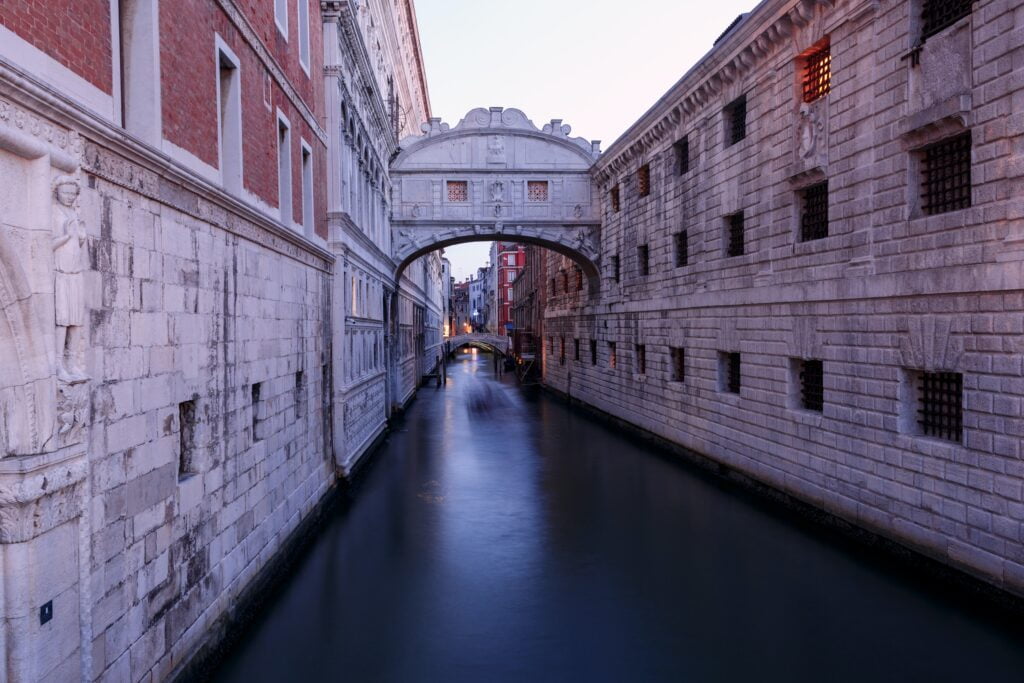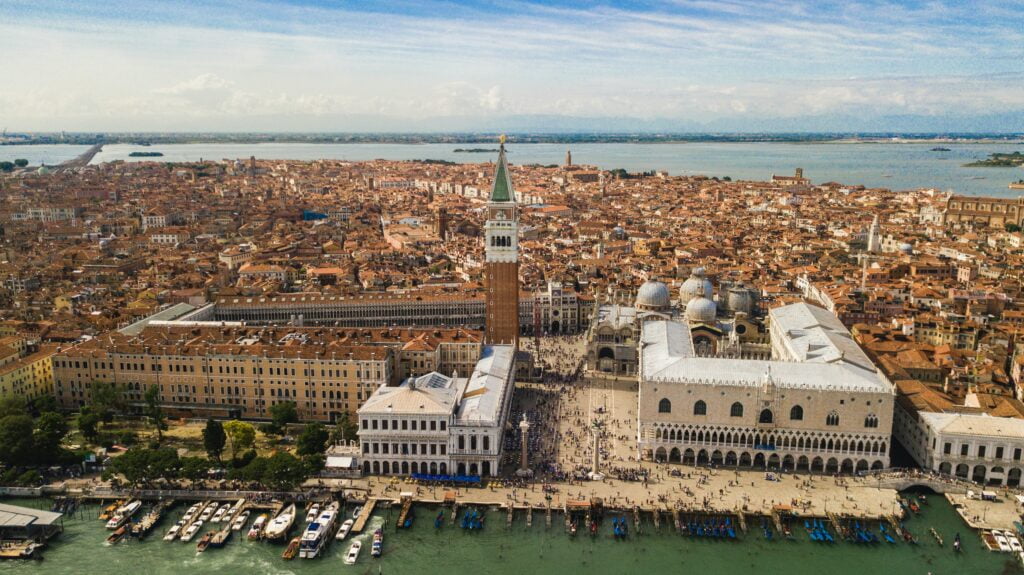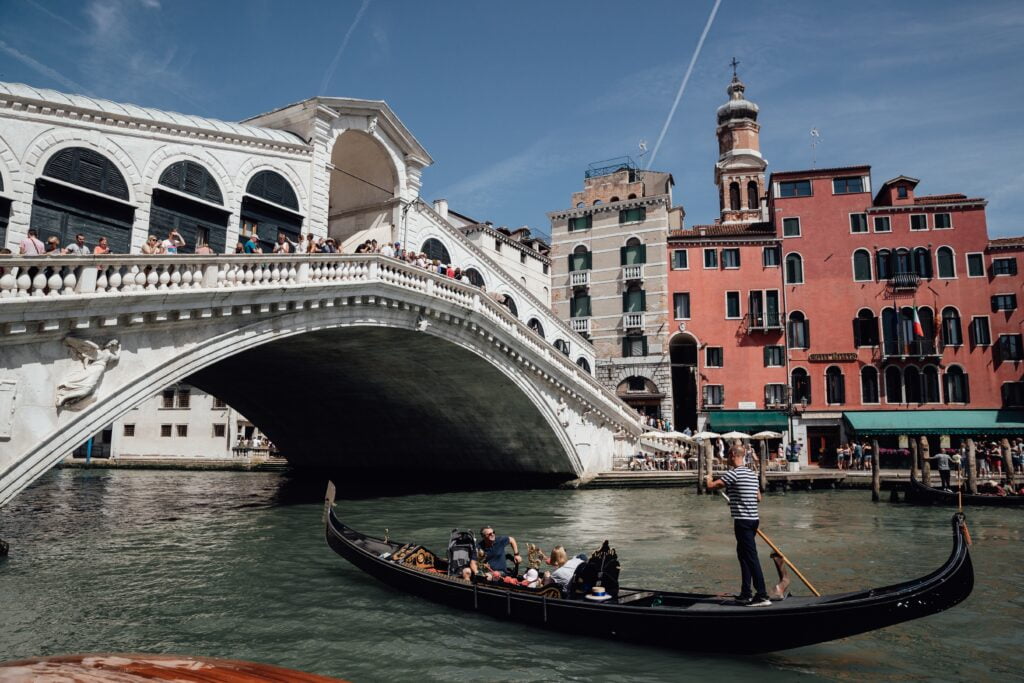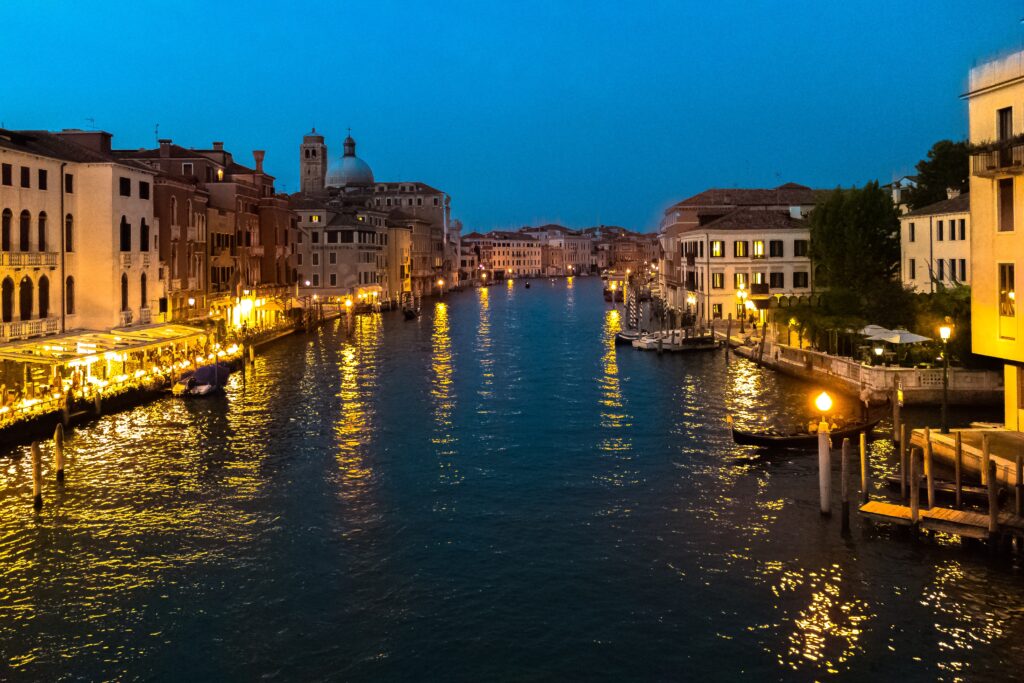
Venice, Italy has been known by many names in the past like the City of Water, City of Bridges, City of Canals, The Floating City, The Queen of Adriatic, and many more. – Information Source
Obviously, Venice in Italy is known for the water around everything, but also known for its architecture and artwork.
Venice is a beautiful Italian gem to discover and it is a walker’s paradise. Venice is considered one of the most romantic places on earth and hence attracts most honeymooners across the globe. Not only the honeymooners, but this city of water is also almost on everyone’s Travel Bucket list.
The city of Venice is so lovely and exciting with miles of canals and tiny alleys to get lost in. There are museums, palaces, ancient town squares to explore, and endless gelato for dessert lovers! It’s almost like it’s begging you to be eaten. Folks you must backpack immediately to visit this city of water Venice, Italy.
Even though, this city Venice, Italy is very expensive, specifically on the main island; you’re going to find tons and tons of crowds all year around. Overcrowding has become a real problem for this beautiful city of water. Keep up with me I’ll tell you a few tips to make an affordable stay in this expensive city of water.
So far, Venice is beautiful in the summer, but unfortunately, you’re not the only person who thinks so. If you are planning for your next big travel, just be prepared for a stunning, yet crowded experience with a lot of tourists running around.
Skip to content of your interest
8 Must visit places in Venice, Italy
- St. Mark’s Basilica –
- One of the oldest churches in the history of Venice with a history of kidnapping a body of Saint Marks.
- The great grand mosaic of 8000 square meters in this church can cover almost one and a half American football grounds. Many pieces of the mosaic are made up of real GOLD.
- You can find more than 500 columns from mixture of 3rd Century to 11th Century.
- This is not the oldest church, but the oldest church in Venice, Italy could be San Giacometto, which very close to the Rialto bridge.
- Just be sure to arrive early if you don’t want to waste your time standing in the queues, this place can get quite busy.
- Piazza San Marco – It is the most vital and beautiful place in the heart of Venice; Piazza is basically a square surrounded with four buildings, one on each side of square. Why called it as Vital, because it is surrounded with 4 attractions of Venice i.e. St. Mark’s Basilica, Doge’s Palace, Museo Correr and Torre dell’ Orologio.
- You’re not allowed to eat or drink and throw garbage on Piazza San Mark; You’re not even allowed to feed pigeons here.
- If you’re looking for nightlife in Venice, then this is the place for you The Piazza San Mark.
- If you’re not visiting here in winter, you can probably walk through the piazza among the famous cafés
- If your pocket allows, you may visit Cafe Florian; the cheapest drink is approximately €10.
- Once Napoleon called it “the world’s most beautiful drawing room“, you already know why.
- Rialto Bridge – Among the four bridges to cross the Grand Canal of Venice, Rialto Bridge is the oldest one and without a doubt it is the most famous one; millions of tourist crosses Rialto Bridge yearly. It connects Piazza San Marco with San Polo which hosts a most colourful market showcasing delicious looking fruits and veggies. They call it Rialto Market, which opens at 9 in the morning till noon.
- Bridge of Sighs – The Bridge of Sighs is one of the most photographed sights in Venice. Bridge of Sighs might look romantic but it has a quite dark history, too. The building got its name from the tale that states criminals who passed through the covered bridge from their interrogation to their prison cell would let out mournful sighs when catching their final glimpse of Venice through the barred windows. You can sigh over this same view while walking over the bridge during a tour of the Doge’s Palace, the only way to make the crossing.
- The Grand Canal of Venice is the largest and most renowned canal in the city of water Venice, Italy. It is nearly four kilometres long and divides Venice in two parts. Venice is a city built on water and the Grand Canal is it’s bustling main street. Lined with lavish Venetian palaces and packed with gondolas, water taxis, and vaporetti (public ferries), this thoroughfare is a feast for the senses. The Grand Canal winds its way through the central neighbourhoods of Venice from the Santa Lucia train station to St. Mark’s Square (Piazza San Marco), passing under the iconic Rialto Bridge along the way, and functions as the scenic main artery for transporting both people and goods around the City of Canals. It is a must visit place while planning a trip to Venice.
- Doge’s Palace was the home of the Doge, the Duke who ruled Venice. Doge’s Palace has an extensive history within the Venetian empire. It is situated on St. Mark’s Square features lovely arches of pink and white marble. The Interior is filled with fine art which allows you to explore some of the incredible rooms that are ages old. It is one of the best things to do in Venice and a place you can’t miss whilst you explore the city.
- Murano Island is close to Venice and is the home of the famous glass blowers. The best way to visit Murano is on a boat tour through the Venice islands. These tours make stops on Murano to see customary glassblowing the island of Burano, renowned for its lace making; and Torcello, believed to be the primary populated island in the Venetian lagoon. Private tours let you enjoy a boat ride across the waters of the lagoon, visits to artisan workshops and factories joined by an expert local escort, and a bit of extra energy for shopping and exploring without having to navigate Venice’s complicated vaporetto (ship) framework between the islands.
- Burano is known for its vibrant colourful houses. The government actually regulates house painting on this Island so the place holds its charisma and antiquity. Wander the streets and appreciate the art galleries and shops. It is one of the top things to do in Venice. A private tour of Burano, Murano, and Torcello islands is a mesmerizing way to explore the less famous corners of the Floating City by boat.






How to get around the city of water Venice, Italy?
Venice is a walker’s city, except if you’re taking water taxis or a floating bus, you’ll walk. You can cross the trenches by foot utilising bridges or take a “traghetto” (a gondola) for $5 USD.
Vaporetto – A vaporetto is a floating “bus” that will get you pretty much wherever you need to go. They’re not cheap, with one way tickets will cost around $9 USD.
| Ticket Validity | Price |
|---|---|
| 24 hour ticket | €20 |
| 48 hour ticket | €30 |
| 72 hour ticket | €40 |
| 7 days pass | €60 |
In case you’re making a trip between islands to Murano, Torcello, or Lido, you’ll be on the equivalent vaporetto system however on a bigger boat known as motonave. The costs are something very similar.
Water taxi – Private water taxis are unbelievably costly and ought to be stayed away from except if you’re in a colossal hurry or you have lots of baggage. Rates start at €15 and afterward €2 each moment. Cabs are metered, or haggle ahead of time. Assuming you need to arrange a water taxi to your hotel, you’ll pay an additional charge.
Everybody knows Venice is costly at any time of year, how to make it affordable?
Money saving tips while your trip to Venice
No matter what time of year you visit Venice, Italy, it’s going to be expensive. It’s always going to be that way and there are very few ways to save money in the city. Here are some ways to you can lower your expenses when you visit the overcrowded Venice to make the city slightly affordable,
Don’t eat at Piazza San Marco – This is the region with the most tourists roam around, hence making it much more costly. Try not to eat here no matter what, regardless of tempting the cafe patios might be.
Cook your own food – Food is one of the greatest expenses in the city so cook when you can. Little business sectors are plentiful around the city, so fill up with some fresh veggies, fruit, cheddar, and wine, and enjoy a delicious meal at a fraction of the cost it would be to go out.
Walk and get lost – Venice is excessively lovely. It’s a thrill just walking around the city seeing the old structures, churches, artists, and the best part is that it gets a bit of people-watching in.
Get the Venezia Unica Pass – If you are going to do lots of touring, this pass will give you discounts to the top museums, tours, and attractions. It is priced to save you money when compared to buying separate tickets.
Drink the faucet water – Ask for tap water or you will automatically get filtered bottled water included on your bill. Moreover you can top off your containers of water at any of the water fountains all through the city.
Buy your own alcohol – You can purchase an incredible jug of wine for €4 ($4.50 USD). Getting your own bottle is a much more reasonable way to greet! Sit in one of the squares except Piazza San Marco, have a glass of wine, and watch the world go by.
Go on a free walking tour – This is a great way to learn the history behind the places you are seeing and to avoid missing any must-visit attractions. Venice Free Walking Tour has a couple of visits that will show you what the city has to offer. Booking in advance is required.

Where to stay in Venice affordably?
Finding an inexpensive place to stay in Venice is challenging, but not impossible. My recommended places are:
Generator Venice – Located on Guideca Island with a view on the main square, it’s a reasonable and clean hostel. You can book sailing trips and other excursions directly at their front desk. The minus is that you will need a pass to get in and out of Guideca, but the boats are every few minutes.
Residenza Veneziana – Right on the canal with gondolas, this hotel has high standards for an affordable price.
Hotel Danieli – One of the best hotels in Venice. Even the lobby is the most gorgeous ever. If you don’t want to spend a ton on staying there, at least check out their restaurant.
You can definitely count on World Travel Packages to arrange an affordable stay at any point of time.
What is the best time to visit Venice, Italy?
Spring is a Wonderful time to visit, it’s not excessively crowded until June.Venice is at its pinnacle in the mid year months. Prices soar, and the groups are intense. Temperatures are around 82°F (28°C) day by day from June through August.
Tourism dials down in the fall and winter, and temperatures are as yet pleasant. However, this is also known as the acqua alta (“high water”) period, where flooding in the streets is common.
In February, Carnival assumes control over the city. It’s an amazing time, however anticipate chaos and expanded costs. Carnival weekends are insanely full but during the weekdays there is less rush and you can still see lovely costumes and feel the ambience of the carnival.
Generally, you will confront crowds wherever you go, however if you can avoid peak summer or April when school is out and the city is loaded up with a great deal of school bunches and extended get-away, you’ll discover the city is lovely to visit.
Places to eat in Venice
As I mentioned earlier food is one of the most expensive thing here in Venice, but if you can afford it’s worth checking following eating points.
- Ristorante Wistèria
- L’ Bacaro de’ Bischeri
- Ristorante La Piazza
- Riviera Ristorante per
- Onnivori – Omnivorous Restaurant
- Alle Corone
- Osteria Alle Testiere
FAQs
Why is Venice a city of water?
Centuries ago most of the Venice was built on mud with a heavy architecture; with time it pushed it down and then high tides played a major role by flooding the city. Now whole Venice is surrounded with Water.
Why is Venice a city of canals?
About 1,500 years ago, residents of the mainland fled to islands in the Venetian Lagoon to escape barbarian invaders. Over time, they built a city on 118 of the islands, and the gaps between the islands became canals. Bridges were added later.
Until the mid-19th Century, Venice wasn’t even connected to the Italian mainland. (A railroad causeway finally was built in 1846, linking the city to the shore–a distance of roughly 4 km or 2.5 miles)
Do the locals speak English?
Some do, but many don’t. (They’re too busy juggling Italian and Venetian dialect.) People who work in the tourist trade generally speak enough English to communicate with visitors. If you can manage a few critical Italian phrases like “Per favore,” “Grazie,” and “Dov’è la toilette?“, you’ll do fine.
What attractions can be visited on the Gondola ride in Venice?
San Marco, Doge’s Palace and St Mark’s Basilica, can be admired through a gondola ride on the canals.
What are the must try cuisines in Venice?
In Venice, try Risotto al nero di sepia and Sarde in saor
